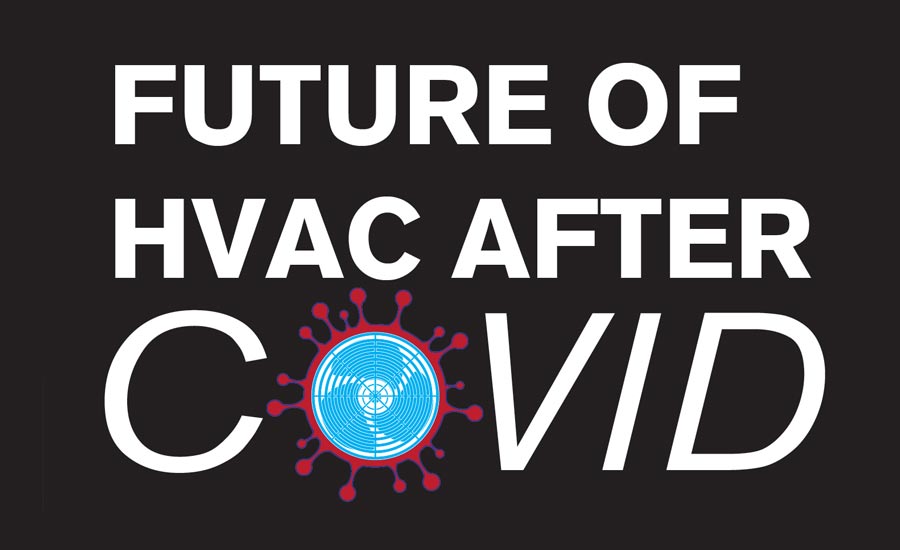
This is the first in a four-part series about what lies in store for the HVAC industry in a post-COVID world. Our coverage will continue on our website.
This last year has been unique in a number of ways. Thanks to the pandemic, most of the U.S. economy was shut down, as people were ordered to stay home in an attempt to halt the transmission of the COVID-19 virus. Initially, many lost their jobs, manufacturers shut down factories, and the economy contracted significantly, leading some economists to believe a long-term recession was inevitable.
Then summer came, and the economy started rebounding as homeowners decided that if they couldn’t travel or eat out, they could invest that discretionary income in home renovations — including new HVAC systems. IAQ products flew off the shelves as more became known about the increased risk of virus transmission indoors.
Now that vaccines are being administered, some people are starting to return to their offices, and it looks like life in the U.S. may finally be returning to normal, it’s time to consider what the post-COVID world could hold in store for the HVAC industry.
Lessons Learned
It is no exaggeration to say that just about everyone learned something about themselves — or their company — as a result of this pandemic. It was a trying time, but how people respond to a crisis or challenge is the true test of leadership as an individual or a company, said Jason Bingham, president of residential HVAC and supply at Trane Technologies.
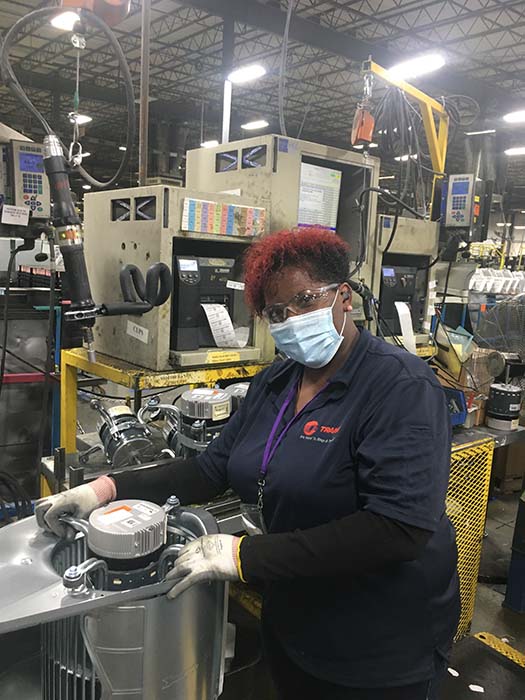
SAFETY FIRST: Early in the pandemic, Trane shut down its manufacturing plants for two weeks in order to ensure the right safety measures and processes were in place. (Courtesy of Trane)
“My biggest takeaway from the pandemic was that by staying true to our business’s purpose and putting people first, we were able to come through this time stronger,” he said. “Early in the pandemic, we shut down our manufacturing plants for two weeks. While that’s not a decision made lightly, taking the time and care to ensure we had the right safety measures and processes in place upfront set us up for success. We’ve made investments to keep our associates and our customers safe through new ways of interacting and new experiences that will shape the future of how we do business.”
Discovering how resilient employees are and how quickly they could adjust to new challenges during the pandemic was inspirational to see, said Randy Roberts, vice president of sales and marketing at Rheem Mfg.
“We put the safety of our employees as a top priority while finding ways to support our contractors and distributors,” he said. “It was a challenging year working with our industry partners to get our industry deemed essential and meeting the incredible demand for our products, especially while a significant portion of our team worked from home. Our sourcing and manufacturing teams went above and beyond to keep our facilities running and producing product, while keeping our employees safe.”
The work by Rheem’s customers and Pro Partners was another takeaway from the pandemic that made Roberts proud to be in this industry. He noted that Pro Partners followed safety protocols and found safe ways to work in homes to service and install Rheem products.
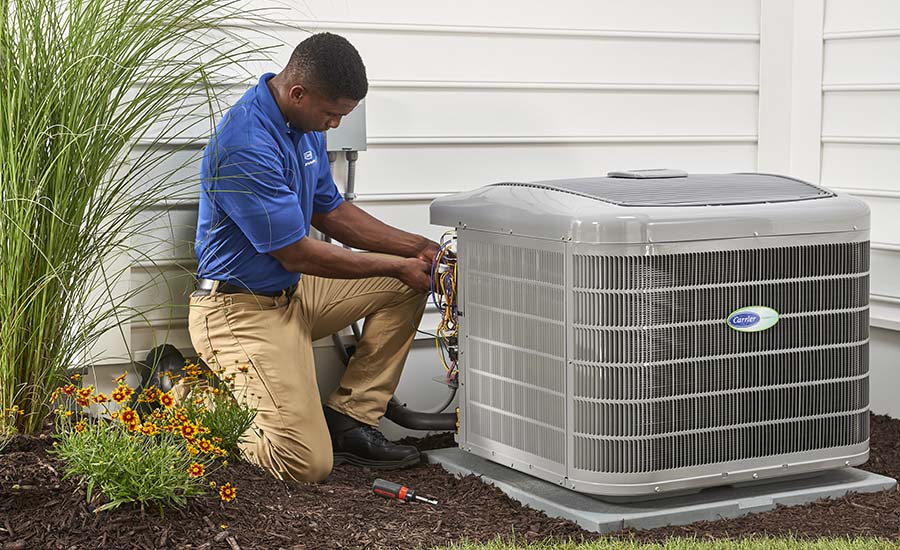
HOME COMFORT: As people are spending more time at home, their home comfort has become increasingly important, leading to a significant uptick in new installations. (Courtesy of Carrier)
“We learned quite a bit about our industry during the pandemic and saw how resilient our distribution network and their contractors were to support a late season spike in demand,” said Justin Keppy, president of North American residential and light commercial HVAC at Carrier. “As people are spending more time at home, their home comfort has become increasingly important. Not only have we seen a significant uptick in new installations and maintenance on existing equipment, we’ve also seen a tremendous increase in interest in IAQ. People are obviously more conscious about the overall health of their home, and the interest in how to improve it has increased dramatically.”
The perseverance and innovation of dealers and customers, as well as HVAC manufacturers, was a key takeaway for Steve Scarbrough, senior vice president of LG Air Conditioning Technologies, LG Electronics USA.
“The HVAC industry has had to deal with supply chain disruptions, followed by logistics issues and then COVID restrictions,” he said. “We have all learned how to thrive in a digital world, a world that relied less on face-to-face interaction and more on technology and innovation. If anything surprised me, it’s how determined we are as a company and as an industry at adopting new and innovative ways to meet the ever-changing global demands.”
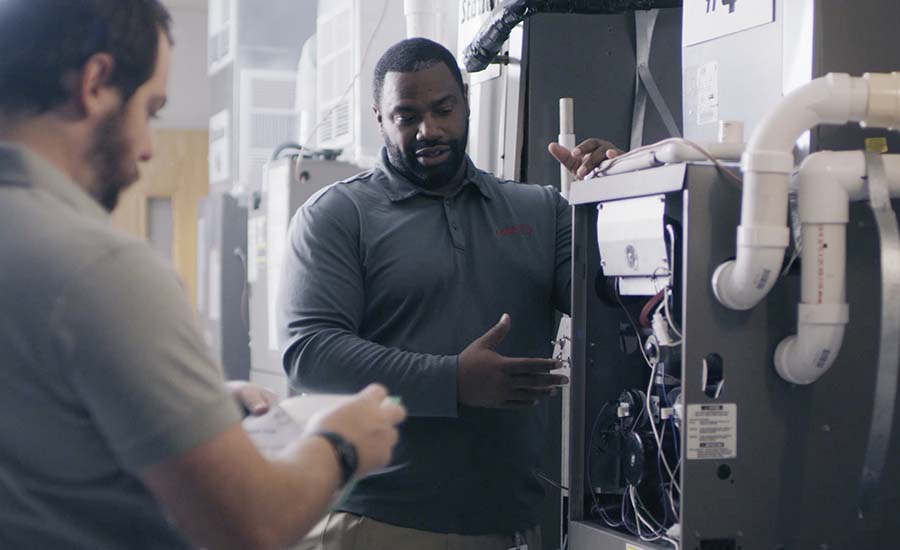
PROPER MAINTENANCE: With the amount of wear and tear experienced by HVAC systems during stay-at-home orders this past year, it’s important to keep equipment properly maintained. (Courtesy of Lennox)
The importance of clean indoor air was also made apparent to Ingrid Berkley, product marketing manager of controls and indoor air quality at Lennox Industries. In fact, in response to the pandemic, Lennox announced new products that include the PureAir™ and PureAir S air purification systems with the Lennox Healthy Climate™ Carbon Clean 16® air filter.
“In a recent survey commissioned by Lennox, we learned that 60% of homeowners are prioritizing air quality in their home now more than a year ago,” she said. “With so many families and individuals spending more time than ever indoors, indoor air quality has become even more crucial to keep loved ones healthy, safe, and comfortable.”
What Comes Next
Even though the pandemic appears to be ebbing in the U.S., there will still be some challenges for manufacturers going forward. First and foremost will be the continued supply chain pressures that are being experienced as the industry works to meet unprecedented demand, said Keppy.
“In addition to commodity inflation and shortages of input materials such as copper, steel, and electronics, many manufacturers are challenged to find the necessary skilled workers to meet the elevated demand,” he said. “Within the current environment, we recognize the importance of redundant sources of supply and manufacturing capabilities, along with robust communications methods with our suppliers and customers to provide visibility of product availability. Things are recovering and wait times are decreasing, but I think we’ll need to create long-term solutions that we can sustain, because I don’t see the interest in home comfort declining anytime soon.”
Roberts agrees that the industry is still seeing the effects of the pandemic, especially when it comes to the global supply chain. He noted that Rheem’s sourcing team is working closely with its suppliers in order to get the materials needed to build their products.
“As we start to move past COVID, we expect some of the challenges facing manufacturers may continue,” he said. “Global supply chain challenges exist and have created issues that manufacturers are continuing to work through. But, overall, we believe we’re in a stronger and more resilient position to react to them today than we were last year. The surprising side of the pandemic has been the high level of demand we have seen for our products as consumers upgrade and renovate their homes. At some point, we expect to see the market slow, but it isn’t showing signs of it yet.”
The industry has learned very quickly that even with a robust economy, a disruption in the supply chain can affect growth, said Scarbrough. And this disruption will likely cause some challenges for the industry going forward.
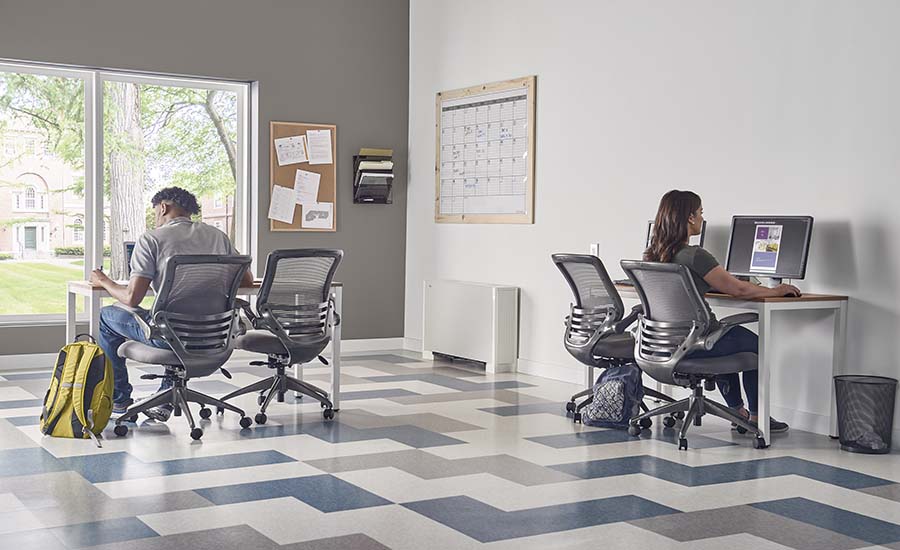
HVAC DEMAND: As students return to class — and employees return to jobs — the demand for HVAC systems, such as the LG floor-standing unit shown here, will continue to grow. (Courtesy of LG)
“During the onset of the pandemic, while demand was diminishing, manufacturers were looking for ways to balance incoming inventory while managing cash flow. With the cost escalations and scarcity of raw materials, ongoing COVID restrictions and a significant rebound in demand, it seems that the industry will still be dealing with some supply chain challenges,” he said. “At LG, we recognized that without an adequate supply of product, our channels and their customers would be forced to experience project delays. By taking a proactive approach, LG has been able to maintain a steady stream of inventory coming into the U.S.”
In addition to these challenges, there will also be opportunities for manufacturers and their dealers. For example, the pandemic has accelerated progress in emerging areas like e-commerce and virtual customer interactions that will continue to be honed and expanded, said Bingham. This could also create a shift in recruitment strategies and open up geographic flexibility in certain areas.
“Another opportunity is that the intense focus on virus transmission and the increased awareness of IAQ has translated into a renewed focus on whole home health, taking into account thermal comfort, IAQ, and sustainability,” he said. “Studies are finding that the vast majority of individuals working from home would like the option to do so even after the pandemic ends. So the focus on home health and the conditions that promote effective work and learning performance need to be considered.”
Indeed, the pandemic has demonstrated just how extensive the remote world can be, encompassing everything from work to school to grocery shopping. This has created hurdles for HVAC professionals, said Berkley, many of whom rely on in-person contact for maintenance, installation, and other common services, but it also presents the opportunity for HVAC innovation and remote possibilities. For example, Lennox gives dealers the capability of allowing long-distance technician and homeowner contact, care, reminders, advice, and more. With smart thermostats, contractors enable remote monitoring, troubleshooting, and diagnostic capabilities that enhance the customer service experience and save everyone time and money.
“The opportunity of continued advancements in the HVAC industry will be more present than ever for our dealers,” she said. “We’ve also seen a rise in interest for IAQ products, and we don’t anticipate that this will go away any time soon. After seeing the power of clean air during the pandemic, we hope this piques interest in homeowners, and they continue to harness their indoor air quality to its full potential.”
The Future
While life may be getting back to normal, there are a few ways in which the pandemic will likely change things forever. For example, contactless service calls and transactions will continue to be important to homeowners, said Keppy, but he adds that dealers will continue to thrive as homeowners remain concerned about the overall health and comfort of their homes.
“People are investing in their homes as they continue to spend so much time in them,” he said. “Plus, many people are now working from home permanently, or at least working from home part time, so as that trend continues, the outlook for our industry will remain positive.”
There may also be a permanent shift to online training, as COVID has forced the industry to evolve, said Roberts. Virtual training is now ubiquitous, and contractors and technicians have quickly adapted to the new training methods and embraced the virtual format. That is not to say that in-person training will be eliminated, but it is likely that online options will remain popular.
And if another pandemic emerges in the U.S. in coming years, Berkley believes that manufacturers will be better prepared to face it after the countless things learned since the start of the COVID-19 pandemic.
“The HVAC industry is constantly innovating to enhance the health and comfort of homeowners and their loved ones,” she said. “While the COVID-19 pandemic has changed the world around us, it hasn't changed Lennox’s unwavering commitment to delivering consistently clean comfortable air to homeowners.”
From LG’s standpoint, the pandemic helped the company become nimbler and more responsive than ever, said Scarbrough.
“With the implementation of digital tools to replace face-to-face interactions and instituting flexible working environments for our team members, we at LG know we can quickly respond to the changing demands of a pandemic,” he said. “We have also learned that if there is a next time, the HVAC industry is an essential industry and as such may have a tendency to recover faster than others. The demand for our products will remain strong, and at LG we will meet those demands.”
As difficult as the pandemic has been, Roberts believes it helped Rheem refine the way it reacts to challenges in every aspect of their business and that they are a more resilient organization as a result.
“Having faced everything from supply chain issues to on-site employee health concerns simultaneously, I believe we are better prepared to address these types of issues moving forward,” he said.
And if approached the right way, adversity can create opportunity, said Bingham. “If we have the mindset of looking for the opportunity rather than simply reacting to the crisis, and stay true to our purpose and values along the way, we will continue to come through challenges stronger. We learned how to run our plants under the constraints of COVID-19, and in doing so, we found gaps in our processes that we are investing to close. This has made us stronger. With that said, and knowing there were many learnings throughout this pandemic, it’s the culture of our company and how we lead that’s truly stronger because of the challenges we’ve faced.”
Everyone learned a lot this last year, noted Keppy, and Carrier, in particular, learned how to assess situations and act quickly in order to help rectify the strain the pandemic put on its customers.
“I think our industry has responded very well to the conditions we’ve seen, and I expect it to behave in much the same way if another pandemic emerges,” he said. “One can never predict the future, but the past year has taught us working together with the consumers’ best interests at heart, we will come out ahead. We certainly have created a blueprint for our company and our customers if something like this would ever happen again, and I think that learning experience has made us a stronger industry.”



Report Abusive Comment